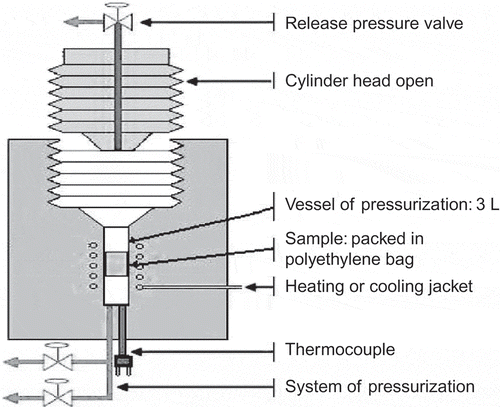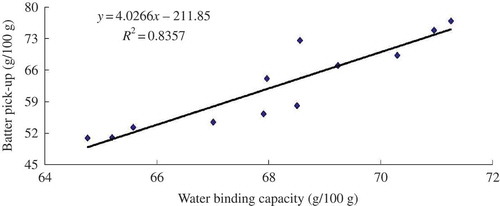Abstract
Batters were subjected to high hydrostatic pressure (HHP) treatment at 150, 300, or 450 MPa for 10 min. Effects of HHP on characteristics of batters and crusts from deep-fat-fried battered (DFFB) pork slices were evaluated. An increase in peak viscosity, trough viscosity, and final viscosity, and a decrease in breakdown viscosity in comparison with untreated batters was observed. A decrease in gelatinization temperatures and enthalpy upon HHP was obtained. HHP altered starch granules’ shape and changed their surface appearance of batters. The crust moisture content showed a steady increase along with the increase of pressure, while oil content decreased significantly. Additionally, HHP changed the crispness profile of crusts with increases in the maximum peak force and the slope of force–time curves. Based on the decrease of oil content and increase of crispness, HHP could be an alternative technique to improve the edible quality of DFFB food.
Las masas fueron tratadas con altas presiones hidrostáticas (aph) de 150, 300 o de 450 MPa durante 10 minutos. Posteriormente, se procedió a evaluar los efectos de aph en las masas y en las cortezas elaboradas con rebanadas de carne de puerco rebozadas y fritas en grasa. En comparación con las masas sin tratamiento, se observó un aumento en la viscosidad pico, en la viscosidad ‘trough’ y en la viscosidad final, así como una reducción en la viscosidad de inestabilidad. Al emplear aph, se obtuvo una reducción de las temperaturas de gelatinización y de entalpía. La aph alteró la forma de los gránulos de almidón y modificó la apariencia superficial de las masas. La cantidad de humedad de la corteza mostró un aumento a medida que se incrementó la presión, mientras que la cantidad de aceite disminuyó significativamente. Asimismo, en la pendiente de las curvas fuerza-tiempo, la aph cambió el perfil crujiente de las cortezas, en consonancia con los aumentos de la fuerza pico máxima. Con base en la disminución del contenido de aceite y en el incremento del aspecto crujiente, se llega a la conclusión de que la aph podría ser una técnica alternativa para mejorar la calidad comestible de los alimentos fritos en grasa.
Introduction
Deep-fat frying is a widely used method for food processing. Batter application prior to frying forms a continuous and uniform layer over the food surface, and it could provide the crisper texture, golden yellow color, and act as a barrier against the loss of moisture by protecting the natural juices of foods (Dogan, Sahin, & Sumnu, Citation2005; Mohamed, Hamid, & Hamid, Citation1998). Batter formula and processing methods, such as frying temperature, frying time, and heating method, could influence the edible quality of crusts (Altunakar, Sahin, & Sumnu, Citation2004; Baixauli, Sanz, Salvador, & Fiszman, Citation2003; Das, Pawar, & Modi, Citation2013; Primo-Martín & van Deventer, Citation2011). Current research in this area is directed to obtain the products with low oil content and high textural characteristics, such as crispness (Gamonpilas et al., Citation2013; Primo-Martín Citation2012).
In the last decades, the development of nonconventional methods for food processing, like high hydrostatic pressure (HHP) processing, has attracted much attention. Many researches were carried out to explore the effect of HHP on specific cereal component properties or model systems, namely starch and gluten (Angioloni & Collar, Citation2012; Kieffer, Schurer, Köhler, & Wieser, Citation2007). HHP could induce starch gelatinization, modify its microstructure and rheological properties, following different mechanisms than thermally induced gelatinization (Li, Bai, Mousaa, Zhang, & Shen, Citation2012). Simultaneously, some scientific reports indicated that HHP produced a weakening effect on gluten when low pressure levels were applied, but an increase in pressure and temperature (800 MPa, 60°C) induced the opposite effect (Bárcenas, Altamirano-Fortoul, & Rosell, Citation2010; Kieffer et al., Citation2007). However, little information is available concerning the effects of HHP on the batters’ physicochemical properties or on the characteristics of the DFFB foods.
The objective of the present investigation was to evaluate the effect of HHP treatment on the pasting properties, thermal properties, microstructure, and pick-up of the batters. Simultaneously, we explored the influence of HHP treatment on the edible quality of crusts from deep-fat-fried battered (DFFB) pork slices, such as the moisture, oil content, and texture.
Materials and methods
Materials
Wheat flour (Wudeli Flour Group, Xinxiang, China), mung bean starch (Shandong jincheng Co., Ltd., Yantai, China), leavening (NaHCO3) (Tianjin Honglu Food Group, Tianjin, China), corn germ oil (Kerry Oils & Grains Ltd, Zhoukou, China), and frozen lean pork hams (Henan Shuanghui Group, Luohe, China) were used in the experiments. All other ingredients used for experiments were obtained from local markets.
Batter preparation and HHP treatment
The batter formulations contained 297 g wheat flour, 198 g native mung bean starch, 5 g leavening agent, 5 g salt, and 594 mL tap water, which were obtained according to our previous study with some minor modifications (Zhang, Li, Ji, Yang, & Hu, Citation2013; Zhang, Yang, Ji, Bian, & Li, Citation2013). The batter was prepared by mixing all ingredients for 3 min using a mixer (Caple, Shunde, China) at speed 2, and conditioned for 1 h at room temperature (25 ± 1°C). Then the batter was divided into 100 g pieces and packed in polyethylene bags (200 mL), which were thermo-sealed under vacuum.
For HHP, the packed batters were placed into the pressurization vessel of HHP device (HHP-750, Kefa Food Equipment Ltd., Baotou, China), and then subjected to different pressures (150, 300, or 450 MPa) at 25°C for 10 min. The schematic diagram of HHP treatment systems was as shown in . The pressure-transmitting medium was water. The pressure level, pressurization time, and temperature were controlled automatically. Pressure was increased at a rate of 120 MPa/min, maintained at the desired pressure for 10 min and released at a rate of 100 MPa/sec. The temperature of the vessel of the pressure unit was thermostatically controlled at 25 ± 1°C throughout treatment. Due to compressive heating, increases in the temperature of the processing fluid by up to a maximum of 8°C at 450 MPa were observed. And the set temperature was re-attained within 3 min of the start of treatment. Batters without HHP were used as control. Samples after each treatment of HHP were evaluated.
Pasting properties
The pasting properties of batters were determined using a Rapid Visco-Analyzer (RVA) model Master (Super 3, New-port Scientific Ltd., Warriewood, Australia) according to the method of Angioloni & Collar (Citation2012) with some modification. Briefly, deionized water (25 g) was added to samples (3 g, dry basis) in the RVA canister to obtain a total constant sample weight of 28 g. The batter slurry was then manually homogenized using the plastic paddle to avoid lump formation before the RVA run. The batter slurry was heated from 50°C to 95°C at the rate of 6°C/min, maintained at 95°C for 5 min, and then cooled to 50°C at the same rate, and maintained at 50°C for 2 min. The pasting temperature (GT), peak time (PT), peak viscosity (PV), trough viscosity (TV), breakdown (BD) (peak viscosity minus trough viscosity), final viscosity (FV), and setback (ST) (final viscosity minus peak viscosity) were calculated from the pasting curve. Every measurement was performed in triplicate.
Thermal properties
Thermal properties were measured by a differential scanning calorimeter (DSC-Q20, TA, New Castle, USA). Freeze-dried samples (3 mg, dry basis) were directly measured into the aluminum DSC pan and 12 µL distilled water was added with a microsyringe. Pans were sealed, and were allowed to stand for 1 h at room temperature for even distribution of water. The scanning temperature and the heating rates were 30–110°C and 10°C/min, respectively. An empty pan was used as reference for all measurements. To stands for onset temperature; Tp, peak temperature; Tc, conclusion temperature; ∆Tr, gelatinization temperature range (∆Tr = Tc–To); and ∆H, enthalpy of gelatinization. Every measurement was performed in triplicate.
Scanning electron microscopy (SEM)
Freeze-dried samples were mounted on SEM stubs using double-tape active carbon, and then coated with a layer of gold. Sample analysis was taken using a scanning electron microscope (Quanta 200, FEI, Oregon, USA) at an accelerating voltage of 15 kV.
Preparation of DFFB pork slices
Frozen lean pork hams were stored at −18°C. Before the experiments commenced, pork hams were thawed at 4°C for 24 h in the refrigerator. Samples of 3 cm (length) × 2 cm (width) × 0.6 cm (thickness) were cut with a manually operated cutting device. The uniformity of sample thickness was checked using a micrometer (111N-101, Guilin Guanglu Measuring Instrument Co. Ltd., Guilin, China). Each sample was immersed in the batters for 10 s and then allowed to drip for 15 s.
The condition of frying was conducted according to our previous study with some minor modifications (Zhang, Li et al., Citation2013; Zhang, Yang et al., Citation2013). Samples were pre-fried in corn germ oil at 180°C for 100 s. They were let to cool down for 10 min and final-fried at 200°C for 40 s in a Wellborn deep-fat fryer (EF101, Guangzhou Wellborn Hotel Equipment Co. Ltd., Guangzhou, China) containing 2.5 L of oil. A copper constantan thermocouple was connected to the fryer in order to control the temperature. Four pieces were deposited into the frying oil each time. After each frying batch, the oil level was checked and the oil was replaced after 6 h of frying time. In all cases, excess surface oil was allowed to drain on tissue paper after frying. After the final frying, the DFFB pork slices were characterized at 15 min after frying and stored at 25°C and 40% relative humidity.
Water retention capacity (WRC) of the batters
The WRC of the batters was analyzed according to the method of Sanz et al. with some minor modifications (Sanz, Salvador, & Fiszman, Citation2004). 30 g batters were placed in 50 mL centrifuge tubes and centrifuged at 17,300 g for 10 min at 15 °C in a refrigerated centrifuge (Sigma 3-18K, Sigma, Osterode am Harz, Germany). After being centrifuged, the supernatant solution was removed and weighed. WRC was expressed as 100% minus the percentage of water released.
Batter pick-up
The pork slices were weighed individually, and immersed in the batters for 10 s. After being dripped for 15 s, the battered pork slices were weighed again to determine the batter mass. The amount of batter adhering to the pork slices was considered as the batter pick-up, which was calculated as follows: Batter pick-up (%) = (A – A0) ÷ A0 × 100, where A = mass of battered pork slices, and A0 = initial mass of pork slices. Triplicates per sample were analyzed.
Moisture and oil contents of crusts from DFFB slices
The moisture and oil contents in the crusts from DFFB pork slices were analyzed at 15 min after final frying. The crusts were removed from the pork slices and cut into small pieces. Each of the weighed samples weighing approximately 3 g was dried in an oven at 105°C until constant weights were achieved. The moisture content was expressed as a percentage by weight of the crust samples (wet basis). Triplicates per sample were analyzed.
The dried samples used for moisture content determination were subsequently extracted with petroleum ether (boiling range 30–60°C) using a Soxhlet extraction system (B-811, Buchi Labortechnik AG, Flawil, Switzerland). The fat content was expressed as percentage by weight of the crust sample (wet basis). Triplicates per sample were analyzed.
Texture analysis
The crispness evaluation of the crusts from DFFB pork slices at 30 min after the final frying was performed by a texture analyzer (TA-XT2i Texture Analyzer, Stable Micro System, Godalming, UK). The crusts were separated from pork slices, cut into rectangular (20 × 10 mm) pieces (about 2 mm thick) and immediately subjected to a shear test using a probe (Heavy Duty Platform (HDP)/Blade Set (BS)). The shear speed was 1 mm/s. The complete profile of the force–time curve was recorded and the values of maximum peak force, slope of the curve, shear distance, and total numbers of force peaks were calculated. Five replicates per sample were analyzed.
Consumer sensory analysis
Consumer sensory evaluation was performed according to the method of Sanz et al. with some minor modifications (Sanz, Salvador, & Fiszman, Citation2008). Fifty consumers were recruited among students and personnel of Henan Institute of Science and Technology, China, on the basis of their interest and availability, and liking or being regular purchasers of DFFB food. They were between 18 and 60 years old (the group was approximately balanced between females and males). The consumers made a blind evaluation of the four sorts of crusts from DFFB pork slices. The four sorts of samples were presented monadically in white plastic containers in a random order. Mineral water was provided to drink. ‘Appearance’, ‘color’, ‘crispness’, ‘flavor’, and ‘overall acceptability’ using a scale with nine boxes labeled on the left with ‘Dislike very much’, in the middle with ‘Indifferent’, and on the right with ‘Like very much’. And for ‘oiliness’ using a scale with three boxes labeled ‘I would like it less oily,’ ‘It is Ok,’ and ‘I would like it more oily.’ The crusts from DFFB pork slices were characterized at 15 min after the final frying.
Statistical analysis
Experimental data were analyzed using one-way analysis of variance (ANOVA), and expressed as mean value ± standard deviation. The least significant difference (LSD) multiple range test was conducted to assess significant differences among experimental mean values (P < 0.05). All statistical computations and analyses were conducted using SPSS version 13.0 for Windows (SPSS Inc., Chicago, Illinois, USA). Correlation coefficient between water-binding capacity and pick-up of batter was calculated using Excel 2003 software.
Results and discussion
Effect of HHP on pasting properties of batters
The pasting properties of batters treated with different HHP are summarized in . Results showed that the batters treated with HHP exhibited a significant increase in the peak viscosity, trough viscosity and final viscosity, and a decrease in breakdown viscosity in comparison with the untreated batters (0.1 MPa) (P < 0.05). These variations might result from the changes of starch granular structures during the transformation of crystalline structure (Katopo, Song, & Jane, Citation2002). The higher setback was observed in the HHP-treated batters, suggesting their higher tendency toward retrogradation. The decrease of breakdown viscosity could be attributed to the reduction in granular swelling. Pasting temperatures were steadily enhanced by the HHP treatment, and at 450 MPa, the increase was up to 1.57°C. The high pasting temperature of batter indicated a higher resistance to swelling and rupture, which could be attributed to the compressive effect of the treatment, which lead to a stronger associative bonding between the starch molecules in the granules (Moorthy, Citation1999).
Table 1. Pasting properties of batters treated with different pressures at 25°C for 10 min.
Tabla 1. Propiedades de pastificado de las masas tratadas con presiones distintas a 25°C durante 10 minutos.
Effect of HHP on thermal properties of batters
The effects of HHP treatment on the onset (To), peak (Tp), and conclusion (Tc) temperatures, and gelatinization temperature range (ΔTr) as well as gelatinization enthalpy (ΔH) of batters, determined by DSC, are summarized in . The untreated batters exhibited higher gelatinization temperatures and enthalpies than all HHP-treated samples at the pressure level of 150 to 450 MPa, which indicated that gelatinization occurred during the pressure treatment. Similar results of decreasing gelatinization temperature and gelatinization enthalpy with increasing pressure had been observed from assays of rice, corn, potato, and wheat starch (Ahmed, Ramaswamy, Ayad, Alli, & Alvarez, Citation2007; Kawai, Fukami, & Yamamoto, Citation2007; Li et al., Citation2011).
Table 2. Thermal properties of batters treated with different pressures at 25°C for 10 min.
Tabla 2. Propiedades térmicas de las masas tratadas con presiones distintas a 25°C durante 10 minutos.
The ΔTr value of HHP-treated batters also decreased with increased treatment pressure, and the ΔTr value of batters treated with 450 MPa for 10 min was 10.34°C, which was much lower than that of the untreated batters (14.26°C) (P < 0.05). It has been reported that the value of ΔTr depended on the stability of crystalline domains of the starch granule, and a higher degree of crystallinity resulted in a higher ΔTr value (Kaur, Singh, Ezekiel, & Sodhi, Citation2009; Li, Shu, Zhang, & Shen, Citation2011). This indicated that HHP treatment could disrupt the crystalline structure of starch granules when water penetrated the granules through channels during the pressurization. The destruction of crystalline structure under pressurization condition could also result in decreasing gelatinization enthalpy (ΔH); this is also observed in .
Microscopy of batters treated with different pressure
Scanning electron micrographs of batters treated with different pressure were showed in . Untreated batters (0.1 MPa) were characterized by having a continuous structure with the intact starch granules embedded in the matrix structure, and the starch granules appeared smooth without pores and fissures. After HHP treatment, the continuous matrix appeared disaggregated and the starch granules were clearly identified as individual structures; however, their structure became more distorted as the pressure level increased. Batters treated with pressures of 150 and 300 MPa showed well-defined starch granules with diverse size, and the surrounding structures (mainly of protein nature) were progressively reduced. In addition, when treated with a pressure of 300 MPa, the agglomerates of starch granules could be observed. Drastic changes were observed in batters treated at 450 MPa, where some starch granules, as individual structures, disappeared adopting a discontinuous film-like organization, similar to what happened after swelling and gelatinization. These observations were in good agreement with those of the previous study on high pressure-treated starch and dough (Bárcenas et al., Citation2010; Kaur et al., Citation2009). Microscopy studies revealed that HHP treatment at 150 MPa for 10 min induced micro-structural changes on batters related to matrix disorganization, but drastic starch modification required higher pressure levels (450 MPa).
Figure 2. Scanning electron microscopy images of batters treated with different pressure (0.1, 150, 300, 450 MPa) at 25°C for 10 min.
Figura 2. Imágenes de las masas tratadas a distintas presiones (0.1, 150, 300, 450 MPa) a 25°C durante 10 minutos, tomadas por medio de microscopía electrónica de barrido.

Pick-up and water-binding capacity of batters
HHP treatment had a significant influence on the amount of batter pick-up (). Percentage pick-up of the batter treated with 450 MPa was 74.79 g/100 g, much higher than those of batters treated with 0.1, 150, or 300 MPa (P < 0.05).
Figure 3. Pick-up of batters treated with different pressures (0.1, 150, 300, 450 MPa) at 25°C for 10 min. Values were means of triplicate determinations. Means bars with different letters are significantly different (P < 0.05), error bars represent standard deviation.
Figura 3. Capacidad de adhesión de las masas tratadas a distintas presiones (0.1, 150, 300, 450 MPa) a 25°C durante 10 minutos. Los valores representan las medias de tres mediciones. Las barras de medias con letras distintas indican la presencia de diferencias significativas (P < 0,05); las barras de error representan la desviación estándar.
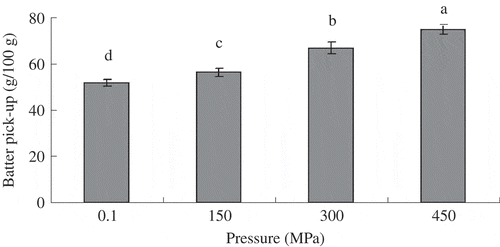
The effects of HHP treatment on water-binding capacity of batters are shown in . Water-binding capacity showed a steady increase along with the increase of pressure. And water binding capacity of batters treated with a pressure of 450 MPa was 70.26 g/100 g, much higher than those of batters treated with pressures of 0.1 and 150 MPa (P < 0.05).
Figure 4. Water binding capacities of batters treated with different pressure (0.1, 150, 300, 450 MPa) at 25°C for 10 min. Values were means of triplicate determinations. Means bars with different letters are significantly different (P < 0.05), error bars represent standard deviation.
Figura 4. Capacidad de adhesión hídrica de las masas tratadas a distintas presiones (0.1, 150, 300, 450 MPa) a 25°C durante 10 minutos. Los valores representan las medias de tres mediciones. Las barras de medias con letras distintas indican la presencia de diferencias significativas (P < 0,05); las barras de error representan la desviación estándar.
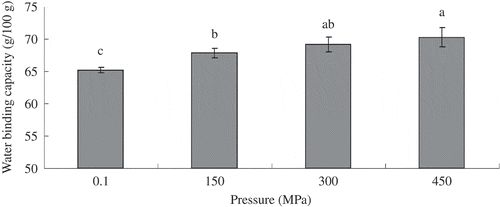
Altunakar et al. (Citation2004) reported that percentage pick-up of the batter with pregelatinized tapioca starch was significantly higher than those of the batters with amylomaize, corn, or waxymaize, apparently due to the higher water-binding capacity of the added starch ingredient. However, the relationship between water-binding capacity and pick-up of batter was not analyzed. So, the relationship between them is explored in the present paper, and the results are shown in . The results indicated that the higher the water-binding capacity, the higher is the pick-up of the batters. Good positive correlations were observed between water-binding capacity and pick-up of batter (R2 = 0.8357) ().
Moisture and oil contents of crusts from DFFB pork slices
The moisture content of crusts from DFFB pork slices showed a steady increase along with the increase of pressure, and the crust moisture content of batters treated with 450 MPa was 33.64 g/100 g, much higher than that of untreated batters (P < 0.05) (). This might be associated with the batters’ ability to retain water.
Figure 6. Effect of HHP (0.1, 150, 300, or 450 MPa at 25°C for 10 min, respectively) on moisture content of crusts from deep-fat-fried battered pork slices. Values were means of triplicate determinations. Means bars with different letters are significantly different (P < 0.05), error bars represent standard deviation.
Figura 6. Efectos de la aph (0.1, 150, 300 o 450 MPa a 25°C durante 10 minutos, respectivamente) en el contenido de humedad de cortezas elaboradas con rebanadas de carne de puerco rebozadas y fritas. Los valores representan las medias de tres determinaciones. Las barras de medias con letras distintas indican la presencia de diferencias significativas (P < 0.05); las barras de error representan la desviación estándar.
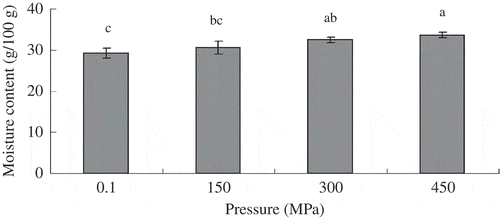
The effects of HHP treatment on oil content of crusts from DFFB pork slices are shown in . The oil content of crusts decreased significantly with increase in HHP; the higher the pressure, the lower was the oil content. The crust oil content of batters treated with a pressure of 450 MPa (15.58 g/100 g) was much lower than those of untreated (18.39 g/100 g) and treated with a pressure of 150 MPa (18.01 g/100 g) (P < 0.05). The highest batter pick-up, which meant efficient coverage of the surface, might have controlled the diffusion of oil into the product, and resulted in the lowest oil content of crusts from deep-fat-fried food when the batters were treated with a pressure of 450 MPa for 10 min.
Figure 7. Effect of HHP (0.1, 150, 300, or 450 MPa at 25°C for 10 min, respectively) on oil content of crusts from deep-fat-fried battered pork slices. Values were means of triplicate determinations. Means bars with different letters are significantly different (P < 0.05), error bars represent standard deviation.
Figura 7. Efectos de aph (0.1, 150, 300 o 450 MPa a 25°C durante 10 minutos, respectivamente) en el contenido de aceite de cortezas de rebanadas de carne de puerco rebozadas y fritas. Los valores representan las medias de tres mediciones. Las barras de medias con letras distintas indican la presencia de diferencias significativas (P < 0,05); las barras de error representan la desviación estándar.

Crispness of the crust
Values of maximum peak force, slope of the curve, shear distance, and total number of peaks, produced during shear tests, are shown in . HHP treatment increased the maximum force, and raised the slope of the curve, indicating an increase in hardness and fracturability, especially for the batters treated with a pressure of 450 MPa. However, no significant differences were found in the total number of peaks. The number of peaks in the force–time curve indicated the number of fracture events. Higher number of peaks in a batter containing dextrin have been associated with a crispier texture (Baixauli et al., Citation2003). Although the number of peaks was not affected by HHP treatment, the increases in the maximum peak force and in the slope of the force-time curves revealed the changes in the crispness profile of crusts from DFFB food caused by HHP treatment.
Table 3. Instrumental texture parameters of crusts from deep-fat-fried battered pork slices containing batters treated with different pressure at 25°C for 10 min.
Tabla 3. Parámetros de textura instrumentales de cortezas elaboradas con rebanadas de carne de puerco rebozadas y fritas que contienen masas tratadas con presiones distintas a 25°C durante 10 minutos.
Acceptability of crusts from DFFB pork slices
The sensory scores of appearance, color, crispness, oiliness, flavor, and overall acceptability for crusts from DFFB pork slices are shown in . HHP treatment increased the edible quality of appearance, color, and crispness of crusts. Additionally, HHP treatment decreased the oil content, especially for the crusts containing batters treated with a pressure of 450 MPa. However, no significant differences were found in flavor (). The scores of overall acceptability were always higher than 5, indicating that all the batters treated with HHP were acceptable.
Table 4. Sensory evaluation of crusts from deep-fat-fried battered pork slices containing batters treated with different pressure at 25°C for 10 min.
Tabla 4. Evaluación sensorial de cortezas elaboradas con rebanadas de carne de puerco rebozadas y fritas que contienen masas tratadas a presiones distintas a 25°C durante 10 minutos.
Conclusions
HHP processing exhibited an increase in the peak viscosity, trough viscosity, and final viscosity, and a decrease in breakdown viscosity in comparison with untreated batters. HHP treatments altered the shape of starch granules and changed the surface appearance of the batters, according to SEM analysis. HHP treatment increased batter WRC and consequently the batter pick-up.
The crusts from DFFB pork slices containing batters treated with different pressure had higher moisture content and less oil after final frying. Texture analysis indicated that HHP processing changed the crispness profile of crusts from the battered food with increases in the maximum peak force and in the slope of the force–time curves. Consumer sensory analysis indicated that the crusts containing batters treated with different pressure were acceptable. Therefore, batters treated with HHP in the pressure range of 150–450 MPa could enhance the quality of DFFB food.
Acknowledgments
This work was supported by Heilongjiang Province Science Foundation for Youths (No. QC2011C093), Foundation of He’nan Educational Committee (No.12A550003), and Program for Innovative Research Team (in Science and Technology) in University of Henan Province (IRTSTHN) of China (No.13IRTSTHN006).
References
- Ahmed, J., Ramaswamy, H. S., Ayad, A., Alli, I., & Alvarez, P. (2007). Effect of high-pressure treatment on rheological, thermal and structural changes in Basmati rice flour slurry. Journal of Cereal Science, 46, 148–156. doi:10.1016/j.jcs.2007.01.006
- Altunakar, B., Sahin, S., & Sumnu, G. (2004). Functionality of batters containing different starch types for deep-fat frying of chicken nuggets. European Food Research and Technology, 218, 318–322. doi:10.1007/s00217-003-0854-5
- Angioloni, A., & Collar, C. (2012). Promoting dough viscoelastic structure in composite cereal matrices by high hydrostatic pressure. Journal of Food Engineering, 111, 598–605. doi:10.1016/j.jfoodeng.2012.03.010
- Baixauli, R., Sanz, T., Salvador, A., & Fiszman, S. M. (2003). Effect of the addition of dextrin or dried egg on the rheological and textural properties of batters for fried foods. Food Hydrocolloids, 17, 305–310. doi:10.1016/S0268-005X(02)00091-7
- Bárcenas, M. E., Altamirano-Fortoul, R., & Rosell, C. M. (2010). Effect of high pressure processing on wheat dough and bread characteristics. LWT – Food Science and Technology, 43, 12–19. doi:10.1016/j.lwt.2009.06.019
- Das, R., Pawar, D. P., & Modi, V. K. (2013). Quality characteristics of battered and fried chicken: Comparison of pressure frying and conventional frying. Journal of Food Science and Technology, 50, 284–292. doi:10.1007/s13197-011-0350-z
- Dogan, S. F., Sahin, S., & Sumnu, G. (2005). Effects of batters containing different protein types on the quality of deep-fat-fried chicken nuggets. European Food Research and Technology, 220, 502–508. doi:10.1007/s00217-004-1099-7
- Gamonpilas, C., Pongjaruvat, W., Methacanon, P., Seetapan, N., Fuongfuchat, A., & Klaikherd, A. (2013). Effects of cross-linked tapioca starches on batter viscosity and oil absorption in deep-fried breaded chicken strips. Journal of Food Engineering, 114, 262–268. doi:10.1016/j.jfoodeng.2012.08.008
- Katopo, H., Song, Y., & Jane, J. L. (2002). Effect and mechanism of ultrahigh hydrostatic pressure on the structure and properties of starches. Carbohydrate Polymers, 47, 233–244. doi:10.1016/S0144-8617(01)00168-0
- Kaur, A., Singh, N., Ezekiel, R., & Sodhi, N. S. (2009). Properties of starches separated from potatoes stored under different conditions. Food Chemistry, 114, 1396–1404. doi:10.1016/j.foodchem.2008.11.025
- Kawai, K., Fukami, K., & Yamamoto, K. (2007). State diagram of potato starch-water mixtures treated with high hydrostatic pressure. Carbohydrate Polymers, 67, 530–535. doi:10.1016/j.carbpol.2006.06.026
- Kieffer, R., Schurer, F., Köhler, P., & Wieser, H. (2007). Effect of hydrostatic pressure and temperature on the chemical and functional properties of wheat gluten: Studies on gluten, gliadin and glutenin. Journal of Cereal Science, 45, 285–292. doi:10.1016/j.jcs.2006.09.008
- Li, W., Bai, Y., Mousaa, S. A. S., Zhang, Q., & Shen, Q. (2012). Effect of high hydrostatic pressure on physicochemical and structural properties of rice starch. Food and Bioprocess Technology, 5, 2233–2241. doi:10.1007/s11947-011-0542-6
- Li, W. H., Shu, C., Zhang, P. L., & Shen, Q. (2011). Properties of starch separated from ten mung bean varieties and seeds processing characteristics. Food and Bioprocess Technology, 4, 814–821. doi:10.1007/s11947-010-0421-6
- Li, W., Zhang, F., Liu, P., Bai, Y., Gao, L., & Shen, Q. (2011). Effect of high hydrostatic pressure on physicochemical, thermal and morphological properties of mung bean (Vigna radiata L.) starch. Journal of Food Engineering, 103, 388–393. doi:10.1016/j.jfoodeng.2010.11.008
- Mohamed, S., Hamid, N. A., & Hamid, M. A. (1998). Food components affecting the oil absorption and crispness of fried batter. Journal of the Science of Food and Agriculture, 78, 39–45. doi:10.1002/(SICI)1097-0010(199809)78:1<39::AID-JSFA82>3.0.CO;2-G
- Moorthy, S. N. (1999). Effect of steam pressure treatment on the physicochemical properties of Dioscorea starches. Journal of Agricultural and Food Chemistry, 47, 1695–1699. doi:10.1021/jf971082m
- Primo-Martín, C. (2012). Cross-linking of wheat starch improves the crispness of deep-fried battered food. Food Hydrocolloids, 28, 53–58. doi:10.1016/j.foodhyd.2011.12.002
- Primo-Martín, C., & van Deventer, H. (2011). Deep-fat fried battered snacks prepared using super heated steam (SHS): Crispness and low oil content. Food Research International, 44, 442–448. doi:10.1016/j.foodres.2010.09.026
- Sanz, T., Salvador, A., & Fiszman, S. M. (2004). Effect of concentration and temperature on properties of methylcellulose-added batters: Application to battered, fried seafood. Food Hydrocolloids, 18, 127–131. doi:10.1016/S0268-005X(03)00050-X
- Sanz, T., Salvador, A., & Fiszman, S. M. (2008). Resistant starch (RS) in battered fried products: Functionality and high-fibre benefit. Food Hydrocolloids, 22, 543–549. doi:10.1016/j.foodhyd.2007.01.018
- Zhang, L. W., Li, F. F., Ji, H. F., Yang, M. D., & Hu, Z. Y. (2013). Effect of batter formula on the quality of battered and fried pork slices. Journal of Henan Institute of Science and Technology, 41, 48–51.
- Zhang, L. W., Yang, M. D., Ji, H. F., Bian, B. B., & Li, J. (2013). Effect of starches on the quality of deep-fried battered pork slices. Science and Technology of Food Industry, 34, 114–117.

